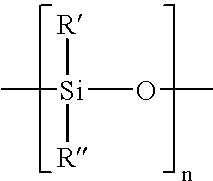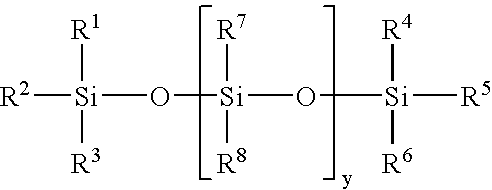Soft and durable tissue products containing a softening agent
a softening agent and softening agent technology, applied in the field of soft and durable tissue products containing softening agents, can solve the problems of contaminating other fibers, creping surfaces, contaminating other fibers, and especially troublesome, and achieve the effect of reducing the hydrophobicity of the compound and improving the retention of softening agents
- Summary
- Abstract
- Description
- Claims
- Application Information
AI Technical Summary
Benefits of technology
Problems solved by technology
Method used
Image
Examples
example 1
[0069] A soft and durable creped tissue made of reactive silicone pretreated fibers was reacted with an amine containing polymer used as a retention agent.
[0070] A dry lap fiber web was made at a basis weight of 180 g / m2 (dry base) and dried to a solid content ranging from 75% to 100% by blending 90% (wt) Aracruz eucalyptus fibers blended with 10% softwood fibers. An epoxy end capped silicone, Sipell RE 35 F or an anhydride silicone IM86, both obtained from Wacker Chemical Corp., was dribbled on this dry fiber lab after the drying stage at a dosage of 10.8 Kg silicone / Ton fibers. The silicone pretreated dry lap was aged at least a week at room temperature.
[0071] A series of creped layered facial basesheets were made with a 32.5% eucalyptus / 35% softwood fibers / 32.5% eucalytpus fiber split at a basis weight of 15.6 g / m2. The reactive silicone pretreated fibers, when present, were blended at 50% with untreated eucalyptus fibers in the tissue outer layers. To some of the samples a sof...
example 2
[0077] Handsheets were constructed with functionalized silicone pretreated fibers reacted with a retention agent and tested for silicone retention, tensile index, wet-out time, slough, wet / dry tensile index (%), elastic modulus, and wet tensile index.
[0078] An eucalyptus drylap pulp sheet available from Aracruz, Brasil, was pretreated with 1% (wt) functionalized silicone and aged 48 hours at ambient conditions. Handsheets were constructed using the standard method described above. Retention agents were incorporated into the handsheets. In particular, amine containing polyelectrolytes, such as KYMENE 6500 (polyamide-polyamine-epichlorohydrin resin), obtained from Hercules, Wilmington Del. (“kymene”) and CATIOFAST VFH (polyvinylamine) obtained from BASF, Ludwigshafen Germany (“PVam”), were used in the wet-end at 5 Kg / T. The polymers were mixed 5 minutes with the thick stock (50 g fibers in 8 L water) prior to handsheet making. In some cases, additional heat was provided by submitting...
example 3
[0087] The effect of wet-end chemistry upon retention of WetSoft CTW silicone (containing amine functional groups) was tested.
[0088] Standard handsheets were constructed from untreated and pre-treated eucalyptus pulp. The untreated eucalyptus pulp was disintegrated for 1 minute in a British Pulp Disintegrator (BPD) at a specific pH. Then, Wetsoft CTW silicone, obtained from Wacker Chemical Corp., was added at 1.1% (wt) on dry pulp to the BPD contents. The disintegration was then completed (4 more minutes) and handsheets were made for silicone retention and physical testing. Wetsoft CTW pretreated pulp (SiPP-2) made at Aracruz, Brazil, was disintegrated in a similar manner and 2 Kg / T PAREZ as a retention agent was added to the BPD after 1 min at a given pH.
[0089] Sample 25 was made with eucalyptus pulp without any reactive silicon additive and no pH control.
[0090] Sample 26 was made with eucalyptus pulp and CTW was added in the BPD at a pH range of 3.5 to 4.
[0091] Sample 27 was m...
PUM
| Property | Measurement | Unit |
|---|---|---|
| wet-out time | aaaaa | aaaaa |
| viscosity | aaaaa | aaaaa |
| volume | aaaaa | aaaaa |
Abstract
Description
Claims
Application Information
 Login to View More
Login to View More - R&D
- Intellectual Property
- Life Sciences
- Materials
- Tech Scout
- Unparalleled Data Quality
- Higher Quality Content
- 60% Fewer Hallucinations
Browse by: Latest US Patents, China's latest patents, Technical Efficacy Thesaurus, Application Domain, Technology Topic, Popular Technical Reports.
© 2025 PatSnap. All rights reserved.Legal|Privacy policy|Modern Slavery Act Transparency Statement|Sitemap|About US| Contact US: help@patsnap.com



